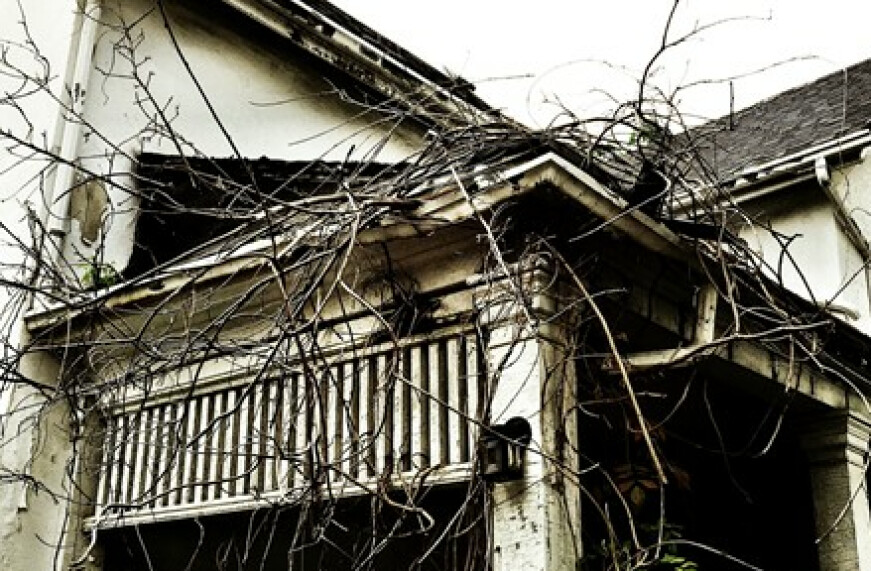Hidden Graces

Hidden Graces
In front of my home, hidden in a lot filled with trees, is an abandoned and broken-down home. During the summer because of the thick foliage, I couldn’t see it. But now every day I see it and lately it has been a source of my reflections. Knowing the history of this area, I know that at one time it was a simple but adequate home for a family. People from Chicago came out to live here seeking refuge from the agitation and violence of the city and in hopes of more economic stability. They found both here. The Catholic Church here has an 81-year history and when I talk with the older folks who are still living here, they speak with sparkling eyes and nostalgia for the community dinners, the celebrations and fun times they had as a faith community.
For various reasons the source of income for the people changed drastically and the factories moved out looking for ways to make more money with less expenses and so the slow exodus began. Without jobs many people left and currently the area has an aging population. But they continue to be a people of great faith and enthusiasm in living this faith.
But that house. It continues to speak to me of mission. At times we are called to be in places and moments of strong connections and activities that nurture the body and soul. I have lived on mission and been on many mission trips and the relationship with people is one of the greatest joys of my life. In my youth, I would have said, “Now this is really mission!” Doing all those marvelous activities that express a new kin-dom of God. We are all kin!
Now already in my golden years, I can look at the abandoned home and thank God for what it was and what it did for the people who lived there. It tells a story, perhaps a melancholy one, but it is a story with a history. It speaks to me of respecting where I am now and where my people are in this faith community. It speaks of the desire to live the reality in which God has placed me.
As we are ending another extremely difficult year, we can see that the call is to live our mission embracing the reality of whatever we encounter in life. Even in the most abandoned moments of our lives, the mystery of God’s love accompanies us and raises us above the difficulties to look beyond with hope and determination. These thoughts continue to resonate with me; they return to my mind and heart because I am certain that in whatever circumstances we find ourselves, nothing can separate us from the love of God. Scripture tells us this. St. Paul lived this and Jesus is glorified in this promise.
Let us not be afraid of abandoned houses and difficult situations but instead, let us risk going deeper to seek the presence of God in all moments because there will be grace present. However, I do say with joy, Come, Lord Jesus, come Emmanuel, come soon 2022!

 Advent because it’s my favorite liturgical season (not just because of the purple), but I wasn’t getting inspired. So, I decided to look at the readings for Wednesday when this would be sent out. Not until I clicked on the USCCB daily readings did I recall that yes, it’s the Feast of the Immaculate Conception. Thanks, Holy Spirit! I have more devotion for this feast after I wrote a paper on Franciscan Friar John Duns Scotus and discovered it was his explanation of how Mary, a human like the rest of us who needed redemption, could be conceived without sin that led to the Immaculate Conception becoming a dogma. I had not known about the vigorous theological debate regarding the concept that had spanned centuries. I’d seen enough Miraculous Medals in my life that I’d not given it a thought. However, in the Roman Rite, Pope Pius IX declared it a dogma in 1854. 1854! In the history of the Church, that is like yesterday. Scotus mapped out his subtle yet brilliant explanation before his death in 1308. It took centuries before the Church officially recognized his work on this idea.
Advent because it’s my favorite liturgical season (not just because of the purple), but I wasn’t getting inspired. So, I decided to look at the readings for Wednesday when this would be sent out. Not until I clicked on the USCCB daily readings did I recall that yes, it’s the Feast of the Immaculate Conception. Thanks, Holy Spirit! I have more devotion for this feast after I wrote a paper on Franciscan Friar John Duns Scotus and discovered it was his explanation of how Mary, a human like the rest of us who needed redemption, could be conceived without sin that led to the Immaculate Conception becoming a dogma. I had not known about the vigorous theological debate regarding the concept that had spanned centuries. I’d seen enough Miraculous Medals in my life that I’d not given it a thought. However, in the Roman Rite, Pope Pius IX declared it a dogma in 1854. 1854! In the history of the Church, that is like yesterday. Scotus mapped out his subtle yet brilliant explanation before his death in 1308. It took centuries before the Church officially recognized his work on this idea.